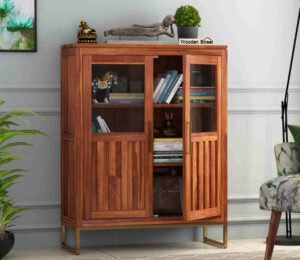Bookshelves are not just a place to store books; they are a reflection of your personality and style. Whether you’re an avid reader with an extensive collection or someone who loves to showcase their decorative items, choosing the right bookshelf is crucial. With a plethora of options available, from classic wooden shelves to modern designs, it’s important to consider several factors to ensure you make the perfect choice for your space.
- Size and Space: Before purchasing a bookshelf, assess the available space in the room where you intend to place it. Measure the dimensions carefully, including height, width, and depth. Consider the ceiling height as well, especially if you’re eyeing tall bookcases. Additionally, think about the layout of the room and how the bookshelf will fit alongside other furniture pieces.
- Storage Needs: Determine the primary purpose of the bookshelf. Are you looking to house a vast collection of books, display decorative items, or a combination of both? Choose a design with the appropriate number of shelves and compartments to accommodate your belongings adequately. Adjustable shelves offer flexibility, allowing you to customize the storage space according to your needs.
- Material and Durability: Wooden bookshelves remain a timeless choice due to their durability and classic appeal. When selecting wood, consider factors such as the type of wood (e.g., oak, pine, mahogany) and its finish. Each type of wood has unique characteristics in terms of grain pattern, color, and strength. Opt for high-quality materials that ensure longevity, especially if you plan to invest in a piece that will last for years to come.
- Style and Aesthetic: Bookshelves come in various styles, ranging from traditional to contemporary designs. Choose a style that complements the existing decor of your room. For a classic look, opt for solid wood bookcases with intricate detailing. If your space leans towards a modern aesthetic, consider sleek, minimalist designs with clean lines. Don’t forget to take into account the color scheme of the room to ensure cohesive interior styling.
- Versatility and Adaptability: Flexibility is key, especially if you anticipate changes in your living space over time. Look for bookshelves that can adapt to different environments or serve multiple functions. Modular bookcases with detachable units or stackable shelves offer versatility, allowing you to reconfigure the layout as needed. Additionally, consider options with built-in features like drawers or cabinets for added functionality.
- Assembly and Installation: Consider the ease of assembly and installation, especially if you’re not keen on complicated DIY projects. Some bookshelves come pre-assembled, while others require assembly upon delivery. Check the product specifications and assembly instructions beforehand to ensure a hassle-free setup process. If you’re not confident in your assembly skills, enlist the help of professionals for proper installation.
- Budget and Value: Set a budget that aligns with your financial constraints, but also consider the value offered by the bookshelf. While it’s tempting to opt for the cheapest option available, prioritize quality and craftsmanship to ensure a worthwhile investment. Evaluate the features, materials, and longevity of the bookshelf to determine its overall value for money.
- Environmental Impact: If sustainability is important to you, consider the environmental impact of the materials used in the bookshelf. Look for eco-friendly options made from responsibly sourced wood or recycled materials. Choosing sustainable furniture not only reduces your carbon footprint but also supports ethical practices within the industry.
- ccessibility and Organization: Consider how easily accessible your books and items will be once placed on the bookshelf. If you frequently reference certain books or need quick access to specific items, opt for shelves that allow for easy organization and retrieval. Adjustable shelves or shelves with varying depths can accommodate items of different sizes, while built-in dividers or compartments help keep things tidy and organized. Think about your organizational preferences and choose a bookshelf design that facilitates efficient storage and retrieval.
- Weight Capacity and Stability: It’s essential to assess the weight capacity of the bookshelf, especially if you plan to load it with heavy books or objects. Solid wood bookcases typically offer excellent stability and can support substantial weight. However, if you opt for a lighter material like particleboard or MDF, ensure that the shelf’s construction and reinforcement can withstand the intended load. Consider factors such as the thickness of the shelves, the quality of the hardware, and the overall structural integrity to prevent sagging or instability over time.
- Maintenance and Care: Different materials and finishes require varying levels of maintenance to keep them looking their best. Wooden bookshelves may need periodic polishing or waxing to maintain their luster and protect them from wear and tear. Additionally, consider factors such as dust accumulation and ease of cleaning when choosing a bookshelf. Designs with smooth surfaces and minimal crevices are easier to dust and wipe clean, ensuring that your bookshelf remains looking pristine with minimal effort.
- Room Layout and Design Cohesion: Lastly, consider how the bookshelf will integrate with the overall layout and design of the room. Think about factors such as traffic flow, focal points, and spatial balance when determining the placement of the bookshelf. A strategically positioned bookcase can serve as a focal point or anchor for the room’s design, enhancing its visual appeal and creating a sense of harmony. Experiment with different placement options and configurations to find the perfect spot that enhances the ambiance and functionality of your space.
Conclusion: Choosing the right bookshelf involves a combination of practical considerations, aesthetic preferences, and lifestyle needs. By carefully evaluating factors such as accessibility, weight capacity, maintenance, and room layout, you can select a bookshelf that not only meets your storage requirements but also enhances the overall look and feel of your living space. Whether you opt for a classic wooden bookcase or a contemporary shelving unit, prioritize quality, functionality, and design cohesion to ensure a stylish and functional addition to your home. 24x7guestpost
